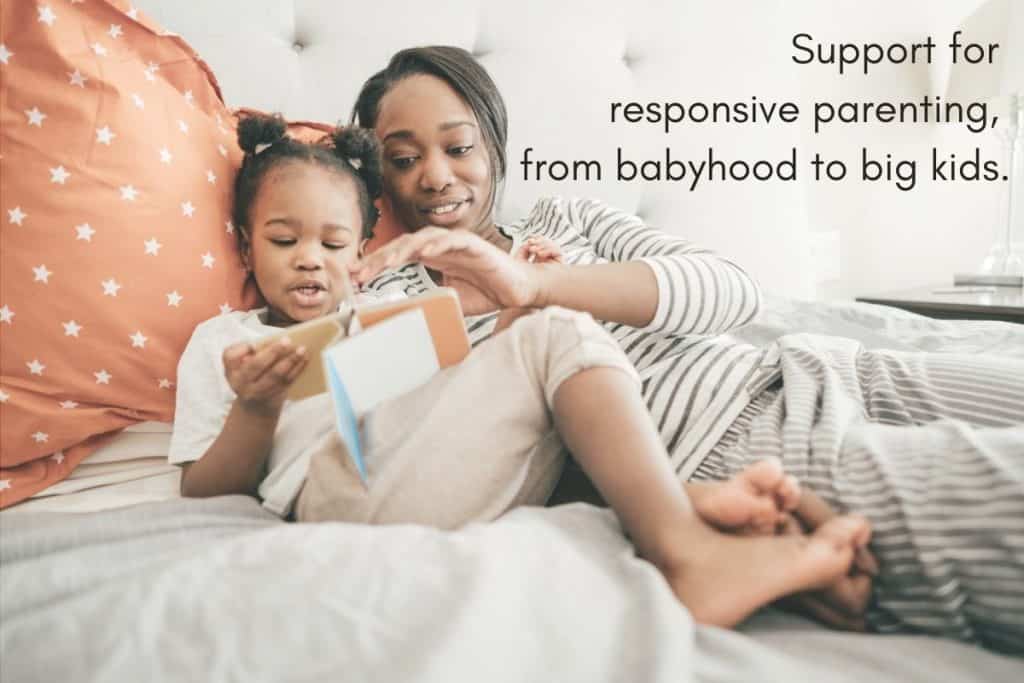
No matter what age your child is, you can respond to her needs. But it can be hard.
Life gets stressful. You know the drill: You’re trying to get dinner on the table, but your oldest child is begging you to watch her do a cartwheel, the 3 year old is leaving all his blocks underfoot, and the baby is crying, exhausted and ready to go to bed.
How do you handle everyone’s needs all at once?
It takes time and so much practice to learn to respond to your kids (instead of just reacting to each “emergency” as it comes).
So whether you’re trying to set up new boundaries and expectations for your home, you need parenting tips for those daily stresses, or you need help keeping yourself in a calm, responsive state, read on for help.
Help with being a mindful parent
Help setting expectations with your kids
Responsive parenting with your baby
Parenting tips for toddlerhood and beyond
First: Use mindfulness to keep yourself responsive
Why am I talking about mindfulness in a page about responsive parenting? Because you can’t parent responsively without mindfulness.
When you’re running on empty, you become an irritable, grouchy mom. It’s not good for you, and it’s not good for your kids.
Find ways to take care of yourself. Whether it’s mindfully sipping on your morning tea or journaling at night, find the thing that makes you feel better and stick with it.
And if you’re really struggling with yelling at your kids, snapping at your partner, or feeling absolutely overwhelmed, know you’re not alone. Parenting is hard, and it brings up some of our most deep-rooted insecurities.
For more in-depth help with changing your mindset so you can parent from a mindful, present place, check out our course, From Reactive to Responsive: Emotional Regulation for Parents.
Setting expectations at home
Routines and expectations are the foundation of gentle, responsive parenting. When your kids know to expect that they’ll get home, they’ll do chores, eat dinner, and then whatever is next on the list, there’s less stress for everyone.
Family rules set the tone for your home. And you know what? We only have three.
You don’t need a huge list of “thou shalt nots.” Instead, inspire your kids to greatness with these three rules.
(And if you want a free printable version, we’ve got it for you right here).
One of our rules is that “families help each other.” And one of the best ways kids can help in the home is to do chores.
But we all know how that goes. You ask your kids to just clean their room “real quick,” and it becomes a battle. An hour later, they’ve built a Lego tower in their room, but there’s still an explosion of toys and clothes everywhere.
How can you get your kids to do their chores without them whining or you nagging?
What you need is a routine that reminds your kids that chores are expected. If you’re looking for a great way to get your kids in the rhythm of daily chores, try our printable chore chart.
Showing your baby you’ll always be there
You and your baby have one main job: To bond. You are there to teach him that the world is a safe place and that you’ll always be there for him.
Unfortunately, a lot of parenting “experts” get this mixed up. They’ll tell you that your baby needs to find his place in the home, and that your job is to teach him a schedule: When to sleep (and for how long), when to eat, when to play.
Don’t worry about all that. You and your little one will find a rhythm as you go. Just show love to your baby.
One of your first challenges together comes around 6 weeks – Purple crying. Suddenly, your baby is screaming all. evening. long. If you’ve never seen this developmental stage before, it can be super stressful.
But you know what? You don’t have to “fix” your baby. After you’ve changed him and fed him, just love him through the crying. You’ll get through it together.
As your baby gets older, his personality develops. It’s so much fun to see, but it also allows your baby to show a new, mischievous side.
Is your baby learning how to roll around and escape your clutches during diaper time? I have a post all about how to keep diaper changes fun for a squirmy baby.
Gentle but firm boundaries with your child
If your child is a little older, you may be wondering where your sweet baby went (and who this screaming toddler is). Even though it’s difficult, it’s okay that your toddler throws tantrums! In fact, it’s a normal stage of development. You just need to learn how to deal with it productively.
RELATED: 6 Steps to calm tantrums
As your child continues to grow, you’ll have more to teach them… How to take turns (read more about why I prefer turn-taking to sharing), how to believe in themselves, and how to stand up for themselves.
One of the best tools you have in parenting is playfulness. If you can turn chores into a game, or get your child out of a bad mood with giggles, everything will be much easier.
Responsive parenting conclusions
The hardest part about responsive parenting isn’t deciding how to discipline your child, it’s learning to keep yourself in a mindful state, where you’re no longer reactive.
If you’re looking for help, start with a free copy of the Mindful Mamas for Connected Kids Action Pack. I look forward to going on this parenting journey with you.

